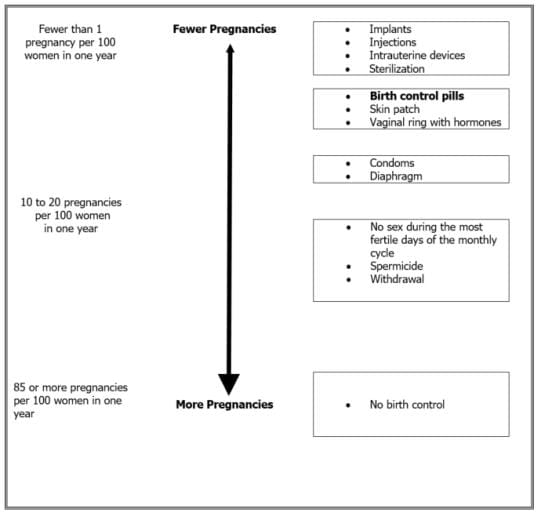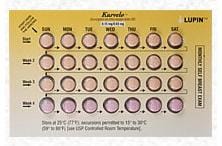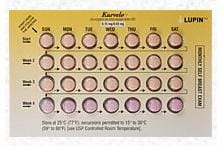What is Tyblume?
- Tyblume is a birth control pill (oral contraceptive) used by women to prevent pregnancy.
- Tyblume does not protect against HIV infections (AIDS) and other sexually transmitted infections
How does Tyblume work for contraception?
Your chance of getting pregnant depends on how well you follow the directions for taking your birth control pills. The better you follow the directions, the less chance you have of getting pregnant.
Based on the results of one clinical study of a 28-day regimen of levonorgestrel 0.1mg/ethinyl estradiol 0.02 mg tablets, about 1 out of 100 women may get pregnant within the first year they use Tyblume.
The following chart shows the chance of getting pregnant for women who use different methods of birth control. Each box on the chart contains a list of birth control methods that are similar in effectiveness. The most effective methods are at the top of the chart. The box on the bottom of the chart shows the chance of getting pregnant for women who do not use birth control and are trying to get pregnant.

What is the most important information I should know about Tyblume?
Do not use Tyblume if you smoke cigarettes and are over 35 years old. Smoking increases your risk of serious cardiovascular side effects (heart and blood vessel problems) from birth control, including death from heart attack, blood clots or stroke. This risk increases with age and the number of cigarettes you smoke.
Who should not take Tyblume?
Do not take Tyblume if you:
- smoke and are over 35 years of age.
- have or have had blood clots in your arms, legs, lungs, or eyes.
- have a problem with your blood that makes it clot more than normal.
- have certain heart valve problems or an irregular heartbeat that increases your risk of having blood clots.
- had a stroke.
- had a heart attack.
- have high blood pressure that cannot be controlled by medicine or have high blood pressure with blood vessel problems.
- have diabetes and are over 35 years of age; have diabetes with high blood pressure, blood vessel problems, or kidney, eye, nerve, or blood vessel damage; or have had diabetes for more than 20 years.
- have certain kinds of severe migraine headaches with aura, numbness, weakness or changes in vision, or any migraine headaches if you are over 35 years of age.
- have liver problems, including liver tumors.
- have any unexplained vaginal bleeding.
- have or have had breast cancer or any cancer that is sensitive to female hormones.
- take any Hepatitis C drug combination containing ombitasvir/paritaprevir/ritonavir, with or without dasabuvir. This may increase levels of the liver enzyme “alanine aminotransferase” (ALT) in the blood.
If any of these conditions happen while you are taking Tyblume, stop taking Tyblume right away and talk to your healthcare provider. Use non-hormonal contraception when you stop taking Tyblume
What should I tell my healthcare provider before taking Tyblume?
Before you take Tyblume, tell your healthcare provider about all of your medical conditions, including if you:
- are scheduled for surgery. Tyblume may increase your risk of blood clots after surgery. You should stop taking Tyblume at least 4 weeks before you have surgery and not restart Tyblume until at least 2 weeks after your surgery.
- are pregnant or think you may be pregnant.
- are depressed now or have been depressed in the past.
- had yellowing of your skin or eyes (jaundice) caused by pregnancy (cholestasis of pregnancy).
- are breastfeeding or plan to breastfeed. Tyblume may decrease the amount of breast milk you make. A small amount of the hormones in Tyblume may pass into your breast milk. Talk to your healthcare provider about the best birth control method for you while breastfeeding.
Tell your healthcare provider about all the medicines you take, including prescription and over-the-counter medicines, vitamins and herbal supplements. Tyblume may affect the way other medicines work, and other medicines may affect how well Tyblume works.
Women on thyroid replacement therapy or steroid therapy may need increased doses of thyroid hormone or steroid medicines.
Know the medicines you take. Keep a list of them to show your healthcare provider and pharmacist when you get a new medicine.
How should I take Tyblume?
- Read the detailed Instructions for Use at the end of this Patient Information leaflet about the right way to take Tyblume.
- Take Tyblume exactly as your healthcare provider tells you to take it.
- You may take Tyblume 1 of 2 ways:
- Chew Tyblume and then swallow Tyblume with a full 8 oz (240 mL) glass of water right away, or
- Swallow Tyblume whole.
- Take Tyblume on an empty stomach
What are the possible side effects of Tyblume?
Tyblume may cause serious side effects, including:
- blood clots in your lungs, heart attack, or a stroke that may lead to death. Some other examples of serious blood clots include blood clots in the legs or eyes. Serious blood clots can happen especially if you smoke, are obese, or are older than 35 years of age. Serious blood clots are more likely to happen when you:
- first start taking birth control pills.
- restart the same or different birth control pills after not using them for a month or more.
Call your healthcare provider or go to the nearest emergency room right away if you have:- leg pain that will not go away.
- sudden severe shortness of breath.
- sudden change in vision or blindness.
- chest pain.
- a sudden, severe headache unlike our usual headaches.
- weakness or numbness in your arm or leg.
- trouble speaking.
Other serious side effects include:
- liver problems, including:
- jaundice. Call your healthcare provider if you have yellowing of your skin or eyes.
- rare liver tumors.
- high blood pressure. You should see your healthcare provider to check your blood pressure regularly.
- gallbladder problems (cholestasis), especially if you previously had cholestasis of pregnancy.
- changes in the sugar and fat (cholesterol and triglycerides) levels in your blood.
- new or worsening headaches including migraine headaches.
- irregular or unusual vaginal bleeding and spotting between your menstrual periods, especially during the first 3 months of taking Tyblume or the absence of menstrual periods (amenorrhea).
- depression.
- possible cancer in your cervix.
- swelling of your skin especially around your mouth, eyes, and in your throat (angioedema). Call your healthcare provider right away if you have a swollen face, lips, mouth, tongue or throat, which may lead to difficulty swallowing or breathing. Your chance of having angioedema is higher if you have a history of angioedema.
- dark patches of skin around your forehead, nose, cheeks and around your mouth, especially during pregnancy (chloasma). Women who tend to get chloasma should avoid spending a long time in sunlight, tanning booths, and under sun lamps while taking Tyblume. Use sunscreen if you have to be in the sunlight.
The most common side effects of Tyblume include:
- headache
- vaginal yeast infection and pain
- stomach (abdominal) pain
- acne
- nausea
- infection or swelling of the vagina that can cause
- vaginal bleeding in between your periods discharge, itching, and pain.
These are not all the possible side effects of Tyblume. For more information, ask your healthcare provider or pharmacist. Call your doctor for medical advice about side effects. You may report side effects to FDA at 1-800-FDA-1088.
What else should I know about taking Tyblume?
If you are scheduled for any lab tests, tell your healthcare provider you are taking Tyblume. Certain blood tests may be affected by Tyblume.
Tyblume Images
-

ethinyl estradiol/levonorgestrel ethinyl estradiol 0.02 mg / levonorgestrel 0.1 mg -

ethinyl estradiol/levonorgestrel ethinyl estradiol 0.01 mg -

ethinyl estradiol/levonorgestrel ethinyl estradiol 0.03 mg / levonorgestrel 0.15 mg -

ethinyl estradiol/levonorgestrel inert -

ethinyl estradiol/levonorgestrel 0.03 mg / 0.15 mg -

ethinyl estradiol/levonorgestrel inert
General information about the safe and effective use of Tyblume
Medicines are sometimes prescribed for purposes other than those listed in Patient Information. Do not use Tyblume for a condition for which it was not prescribed. Do not give Tyblume to other people, even if they have the same symptoms that you have. It may harm them.
You can ask your pharmacist or healthcare provider for information about Tyblume that is written for health professionals.
How should I store Tyblume?
- Store the blister card that Tyblume comes in at room temperature between 68°F to 77°F (20°C to 25°C).
- Protect Tyblume from light.
- Protect Tyblume from high heat.
Keep Tyblume and all medicines out of the reach of children.
What are the ingredients in Tyblume?
White tablets
Active ingredients: levonorgestrel and ethinyl estradiol
Inactive ingredients: corn starch, crospovidone, lactose monohydrate, magnesium stearate, povidone, and pregelatinized starch.
Peach tablets
Inactive ingredients: anhydrous lactose, corn starch, crospovidone, D&C yellow No. 10 aluminum lake, FD&C Red No. 40 aluminum lake, magnesium stearate, and povidone.
Instructions for use for Tyblume
Tyblume [tye bloom]
(levonorgestrel and ethinyl estradiol tablets) for oral use
Important information about taking Tyblume (a type of birth control pill):
- Take 1 pill every day at the same time. Take the pills in the order directed on your blister pack.
- You may either chew 1 pill and then swallow it with a full 8oz (240mL) glass of water right away, or swallow the pill whole. Take the pill without food (on an empty stomach). Take the white pills and the peach pills the same way.
- Do not skip your pills, even if you do not have sex often. If you miss pills (including starting the pack late) you could get pregnant. The more pills you miss, the more likely you are to get pregnant.
- If you have trouble remembering to take Tyblume, talk to your healthcare provider. When you first start taking Tyblume, spotting or light bleeding in between your periods may occur. Contact your healthcare provider if this does not go away after a few months.
- You may feel sick to your stomach (nauseous), especially in the first few months after starting Tyblume. If you feel sick to your stomach, do not stop taking Tyblume. The nausea will usually go away. If your nausea does not go away, call your healthcare provider.
- Missing pills can also cause spotting or light bleeding in between your menstrual periods, even when you take the missed pills later. On the days you take 2 pills to make up for missed pills (see “What should I do if I miss any Tyblume tablets?”), you could also feel sick to your stomach.
- Some women miss periods on hormonal birth control, even when they are not pregnant. However, if you miss a period and have not taken Tyblume according to the directions, or miss 2 or more periods in a row, or feel like you may be pregnant, call your healthcare provider. If you have a positive. pregnancy test, you should stop taking Tyblume.
- If you have vomiting or diarrhea within 3 to 4 hours of taking your pill, take another pill of the same color (that was originally scheduled for you to take the next day) from your blister pack. If you miss more than 2 pills, see “What should I do if I miss any Tyblume tablets?”
- Continue to take all of your remaining pills in order. Start the first pill of your next blister pack the day after you finish your current blister pack. This will be 1 day earlier than originally scheduled. Continue on your new schedule.
Before you start taking Tyblume:
- Decide what time of day you want to take your pill. It is important to take it at the same time every day and in the order as directed on your blister pack.
- Have non-hormonal backup birth control (such as condoms or spermicide) available and an extra full pack of pills as needed.
When should I start taking Tyblume?
If you start taking Tyblume and you have not used a hormonal birth control method before:
- There are 2 ways to start taking your birth control pills.
- You can either start on a Sunday (Sunday Start) after you period starts, or
- You can start on the first day (Day 1) of your natural menstrual period (Day 1 Start).
Your healthcare provider should tell you when to start taking your birth control pill.
If you use the Sunday Start, use a non-hormonal back-up birth control method such as condoms or spermicide for the first 7 days that you take Tyblume. You do not need a back-up birth control method if you use the Day 1 Start.
If you start taking Tyblume and you are switching from another birth control pill:
- Start your new Tyblume pack on the same day that you would start the next pack of your previous birth control method.
- Do not continue taking the pills from your previous birth control pack.
If you start taking Tyblume and previously used a vaginal ring or transdermal patch:
- Start using Tyblume on the day you would have reapplied the next vaginal ring or transdermal patch.
If you start taking Tyblume and you are switching from a progestin-only method such as an implant or injection:
- Start taking Tyblume on the day of removal of your implant or on the day when you would have had your next injection.
If you start taking Tyblume and you are switching from an intrauterine device or system (IUD or IUS):
- Start taking Tyblume on the day of removal of your IUD or IUS.
- You do not need a back-up birth control method if your IUD or IUS is removed on the first day (Day 1) of your period. If your IUD or IUS is removed on any other day, use a non-hormonal back-up birth control method such as condoms or spermicide for the first 7 days that you take Tyblume.
If you start taking Tyblume after you have given birth (postpartum) and have not yet had a menstrual period, use an additional method of birth control (such as condoms or spermicide) for the first 7 days that you take Tyblume.
Keep a calendar to track your menstrual period:
If this is the first time you are taking birth control pills, read, “When should I start taking Tyblume?” above. Follow these instructions for either a Sunday Start or a Day 1 Start.
Sunday Start:
You will use a Sunday Start if your healthcare provider told you to take your first pill on a Sunday. Use a nonhormonal back-up birth control method (such as condoms or spermicide) for the first 7 days of the first cycle that you take Tyblume.
Instructions for using your pill pack:
- Look at your Tyblume pack.
- Take pill 1 on the Sunday after your period starts.
- If your period starts on a Sunday, take pill “1” that day and see “Day 1 Start” instructions below.
- Take 1 pill every day in the order on the blister pack at the same time each day for 28 days.
- After taking the last pill on Day 28 from the blister pack, start taking the first pill from a new pack, on the same day of the week as the first pack (Sunday). Take the first pill in the new pack whether or not you are having your period.
You will use a Day 1 Start if your healthcare provider told you to take your first pill (Day 1) on the first day of your period.
- Take 1 pill every day in the order of the blister pack, at the same time each day, for 28 days.
- After taking the last pill on Day 28 from the blister pack, start taking the first pill from a new pack, on the same day of the week as the first pack. Take the first pill in the new pack whether or not you are having your period.
Instructions for using your pill pack:
Step 1.
Look at your Tyblume pack.
The Tyblume pack has:
- 21 white (active) tablets (pills) with hormones for Week 1 through Week 3
- 7 peach (inactive) tablets (pills) without hormones for Week 4
Step 2.
Find what day of the week you are to start taking your pills. If your period begins on a day other than Sunday, place the day label strip that starts with the first day of your period. For example, if your period begins on Monday, place the day label strip with Monday as the first day.
Step 3.
Remove the white pill by pressing the pill through the foil in the bottom of the pill pack. Continue taking the white pills every day for 21 days.
Step 4.
On the first day of Week 4 start taking the peach pills. Take 1 peach pill every day for 7 days. Your period should start during this time.
Step 5.
When you have taken all the peach pills in your pill pack, get a new pill pack and start taking the white pills.
- For a Day 1 start:
Begin your next pill pack on the same day of the week as your first cycle pill pack. - For a Sunday Start:
Begin your next pill pack on Sunday.
What should I do if I miss any Tyblume tablets?
If you miss 1 white pill in Weeks 1, 2, or 3 of your pill pack, follow these steps:
- Tale it as soon as you remember. Take the next pill at your regular time. This means you may take 2 pills in 1 day.
- Then continue taking 1 pill every day until you finish the pack.
- You do not need to use a non-hormonal back-up birth control method if you have sex.
If you miss 2 white pills in Week 1 or Week 2 of your pill pack, follow these steps:
- Take 2 pills as soon as possible. Then take 2 pills the next day. This means you will take 4 pills in 2 days.
- Then continue to take 1 pill every day until you finish the pack.
- Use a non-hormonal back-up birth control method (such as a condom or spermicide) if you have sex during the first 7 days after missing pills.
If you miss 2 white pills in a row in Week 3, or you miss 3 or more white pills in a row during Weeks 1, 2, or 3 of your pill pack, follow these steps:
- If you are a Day 1 Starter:
- Throw away the rest of the pill pack and start a new pack that same day.
- If you are a Sunday Starter:
- Keep taking 1 white pill every day until Sunday. On Sunday, throw away the rest of the pack and start a new pack of pills that same day.
- You may not have your period this month, but this is expected. However, if you miss your period 2 months in a row, call your healthcare provider because you might be pregnant.
- You could become pregnant if you have sex during the first 7 days after you restart your pills. You should use a non-hormonal birth control method (such as a condom or spermicide) as a back-up if you have sex during the first 7 days after you restart your pills.
If you miss 1 or more peach pills in Week 4
- Throw away the missed pills.
- Keep taking 1 pill every day until you finish the pack.
- You do not need to use a non-hormonal back-up birth control method (such as condoms or spermicide).
- Make sure you start your next pack on time.
If you have any questions or are unsure about the information in this Instructions for Use, call your healthcare provider. You may also read the Patient Information.





